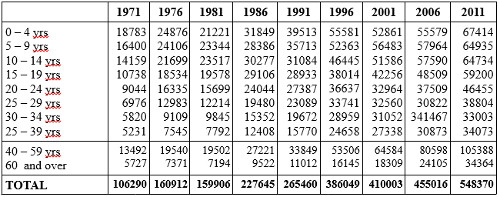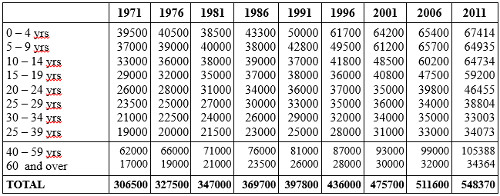Indigenous people have been counted in State censuses since the earliest days, but were first officially counted in the Commonwealth Census only in 1971. 106,290 Indigenous people were recorded in that Census.
Forty years later, in the 2011 Census, 548,370 Indigenous people were recorded. On the face of it, that's better than a fivefold increase, a phenomenal average annual growth over those years of 4.2%.
But it gets complicated. For example, at the 1971 Census, there were 18,783 Indigenous people recorded in the 0 to 4 year-old age-cohort. Thirty five years later, at the 2006 Census, when that same age-cohort was aged 35 to 39 years, even with some inevitable mortality, there were 30,873 Indigenous people recorded, twelve thousand, or nearly two-thirds more. But follow any age-cohort back from the 2011 Census and you will read the same story:
Advertisement
Table A: Combined Census Data, 1971-2011

But how can an age-cohort 'grow' ? And by so much ?
Clearly, either methods of counting improved, or more people decided to identify as Indigenous at one Census than in the previous Census. That is quite legitimate: people have the right to classify themselves as they wish. But it knocks the daylights out of any chance of accuracy, and of prediction: it may account for huge 'rises' from one Census to the next: 1996 figures being 45 % over those of 1991, for example – and in fact, there rises in all age-cohorts in 1996.
So there seem to be serious problems – not so much with the Indigenous population itself, but with the reliability of observations about population growth from one Census to the next, and with predictions for future growth, and therefore for policy decisions.
Undeniably, most people identifying as Indigenous at one Census, but not in previous Censuses, existed at the time of those previous Censuses. Let's call them the 'underlying population', for want of better term. So, in order to have some rough idea of the earlier Indigenous populations, we have to use that later Census, including that 'underlying population', as a guide to re-constructing earlier population sizes, while also taking mortality between Censuses into account. If we do that, we come up with radically different populations in earlier Censuses before 2011.
Advertisement
If we take the 2011 Census figures as they stand, and follow back each age-cohort, building in a rough figure for mortality between Censuses (roughly 11,000 Indigenous people pass away between the five-yearly Censuses, according to the ABS), we can devise an estimate which includes people who identified as Indigenous at the time of each Census as well as people who would identify as Indigenous only at later Censuses, i.e. who actually existed at earlier times but chose not to identify back then, the 'underlying population':
Table B: Adjusted Census Data, 1971-2011, adjusting back from 2011 Census

Discuss in our Forums
See what other readers are saying about this article!
Click here to read & post comments.
34 posts so far.